Repainting Interior Walls: A Step-by-Step Guide
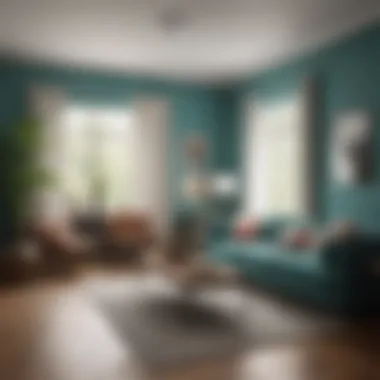
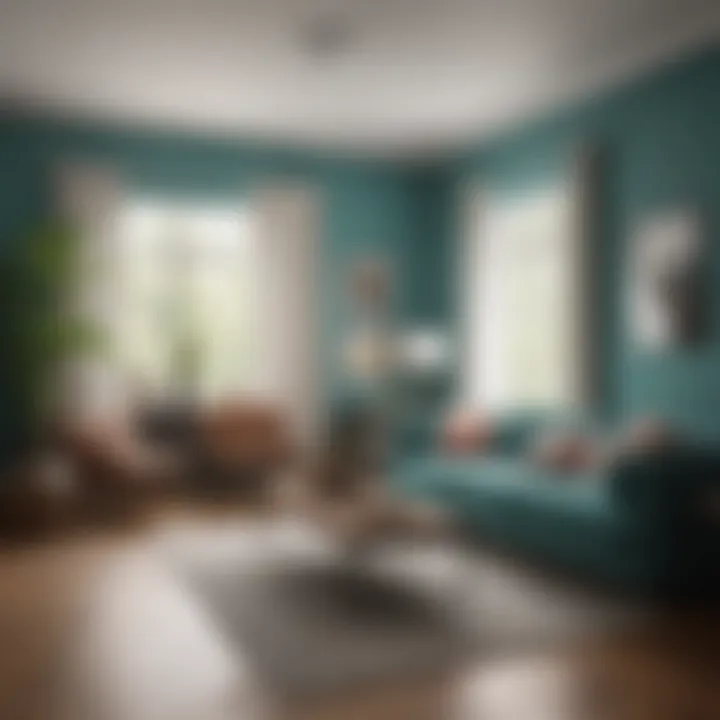
Intro
Repainting interior walls is more than just a matter of changing colors; it is a vital task for enhancing the ambiance and, in many cases, the value of a property. For homeowners and renters alike, a well-done paint job can breathe new life into a stale environment and provide a refreshing atmosphere. This guide aims to explain in detail the necessary steps for achieving a professional finish, from preparation to post-paint care.
Choosing the right type of paint and color schemes can seem daunting, but it is essential for the overall success of your project. The article offers valuable insights into current trends, popular colors, and environmentally friendly options. Achieving great results requires an understanding of materials, tools, and methods, which we will delve deeper into.
By breaking down the process into manageable steps, this guide intends to empower you to take on the task with confidence and thoroughness. Let’s explore the various facets of repainting your interior walls effectively.
Understanding the Need for Repainting
Repainting the interior walls is not just a matter of aesthetics; it is essential for maintaining a home's overall condition and appeal. Understanding the necessity for repainting involves considering various factors such as wear and tear, color fade, and an evolving sense of style. The walls in a home endure constant exposure to elements like sunlight, moisture, and the fingerprints of daily life. When these wears are ignored for too long, they can lead to a drab environment that may negatively impact mood and comfort.
Reasons to Repaint Interior Walls
There are numerous reasons to consider repainting interior walls. One of the most prevalent causes is the accumulation of dirt, grime, and stains. Over time, these can make even the most beautiful paint job appear unattractive. If you have children or pets, it is likely that peeling or scuffed walls become a regular sight in your home. Similarly, smoke from cooking or tobacco can lead to discoloration of paint over time.
Another key reason for repainting is making a home suitable for resale. A fresh coat of paint can extensively increase a home's value, making it more appealing to potential buyers. Neutral colors tend to have broad appeal, allowing individuals to envision their own style in the space.
Moreover, interior trends shift frequently, and individuals often feel the urge to update their surroundings to match current styles. An old color scheme may feel outdated or simply not reflect the current tastes of a household.
Benefits of Fresh Paint
Fresh paint offers a multitude of benefits that extend beyond aesthetics. Firstly, it can greatly enhance the ambiance of a room. Colors have psychological effects on mood, and a fresh palette can create a more welcoming and energizing environment.
Additionally, modern paint products often provide enhancements such as durability and resistance to moisture. This is critical in areas like kitchens and bathrooms, where humidity is frequent. It can also shield against mildew and extend the lifespan of walls.
Furthermore, repainting can serve as an opportunity to incorporate healthier paint options. Choosing low-VOC (volatile organic compounds) paints can improve indoor air quality, reducing health risks associated with traditional paint choices.
"A simple change in paint can transform one's perspective of a space, making everyday life feel fresh and renewed."
The benefits of repainting stretch beyond mere aesthetics. It can allow for personalization of space as well as improve the overall health of the environment within your home. Thus, understanding the reasons and benefits of repainting helps homeowners and design enthusiasts recognize its significance in housekeeping and design.
Planning Your Project
Planning is a fundamental phase in any painting project. By establishing a clear approach from the beginning, you can effectively streamline your efforts and minimize unexpected problems later. A well-designed plan helps allocate time and resources wisely, while also ensuring that objectives align with the desired results. Proper planning can mean the difference between a smooth execution and a hectic undertaking.
Assessing the Condition of Walls
Before applying any paint, it is crucial to assess the current state of your walls. Look for issues such as flaking paint, cracks, or moisture damage. Depending on the severity of the problems, repairs might be necessary. Small cracks can often be patched with spackling compound, while larger issues may require professional intervention. Not only does this step ensure a better surface for painting, but it also prevents future complications that may arise from neglecting underlying problems.
Setting a Budget
Creating a realistic budget sets the foundation for your project. Consider all anticipated costs, including paint, tools, and any required repairs. Paint quality can vary greatly, affecting both price and finish. It might be tempting to select the cheapest options, but investing in higher quality materials often yields better outcomes. You may also want to factor in potential hiring of professionals, especially if the project scope extends beyond your comfort level. Allocating a contingency fund for unforeseen expenses is advisable as well.
Choosing a Color Scheme
Your choice of color can fundamentally alter the perception and ambiance of a space. Understanding how colors interact with each other and with light is essential.
Understanding Color Psychology
Color psychology is the study of how colors affect human emotions and behavior. Each color can evoke different feelings. For example, blue is often associated with calmness, while red can elicit energy and passion. When selecting a color scheme, consider how you want each room to feel. Rooms designed for relaxation may benefit from cooler tones, whereas more energetic spaces like playrooms can use brighter, more stimulating hues. Integrating color psychology is beneficial as it creates a cohesive emotional tone throughout your home.
Sample Boards and Swatches
Using sample boards or paint swatches is a practical method for visualizing your color choices in your environment. Sample boards allow you to apply paint on a surface, giving you a clearer idea of how the color will appear once dry. Furthermore, it lets you explore different shades in various lighting conditions of your space. One advantage of this approach is that it minimizes the risk of commitment to a shade that may not work as well in practice as it does in theory. However, this stage may consume some time and patience as final decisions can be difficult to make.
Proper planning, including assessing wall conditions and setting a budget, can greatly improve the outcome of your painting project.
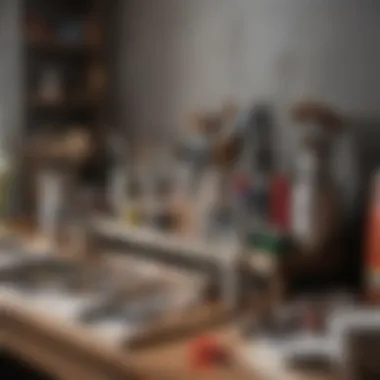
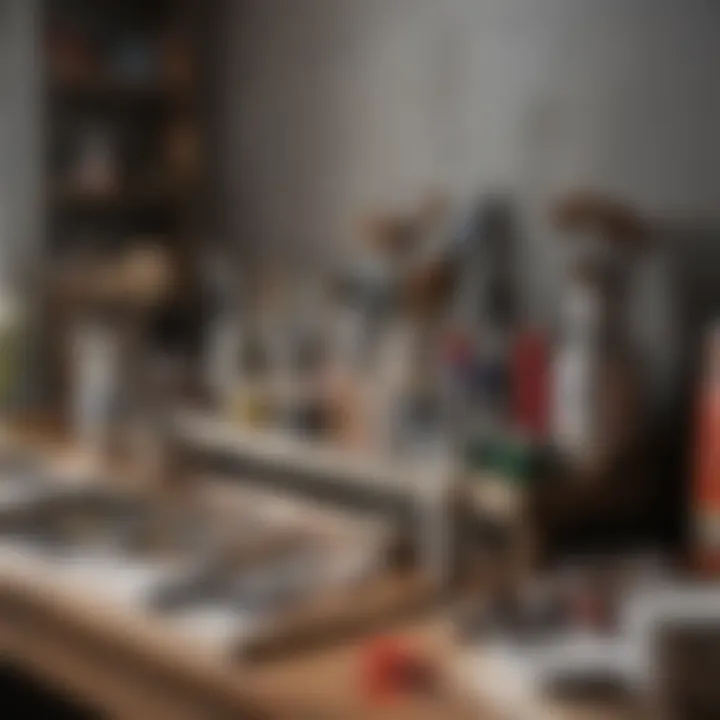
Selecting the Right Materials
Selecting the right materials for repainting is crucial to achieving the desired results. The choice of paint and tools can influence not just the appearance of walls, but also the durability of the finish. Understanding materials available can help prevent issues such as peeling paint, uneven coverage, and incorrect finishes. In this guide, we will discuss the types of interior paint and tools necessary for repainting.
Types of Interior Paint
Matte vs. Satin
Matte paint and satin paint offer different visual effects and functionalities. Matte paint has a non-reflective surface that can give walls a smooth, elegant appearance. This finish can be good for hiding imperfections, making it a popular choice for ceilings or less-trafficked areas. However, matte surfaces can be harder to clean and may require more touch-ups over time.
On the other hand, satin paint has a slight sheen that makes it more durable and easier to clean. This type is especially useful for high-traffic areas like hallways or children’s rooms. The reflective quality of satin can highlight architectural features, which adds another layer of creativity to a painted space. Both finishes have their advantages and disadvantages, and the choice between them should be based on the specific needs of each room.
Eggshell and Gloss Finishes
Eggshell finish lies somewhere between matte and satin in terms of sheen and durability. It provides a soft, velvety appearance and is easier to clean than matte paint. Eggshell can work well in living rooms or dining areas, offering both beauty and practicality.
In contrast, gloss finishes are highly reflective and offer the most durability. They are easy to clean and stand up well against wear. Gloss paint is often used for trim, doors, and cabinets. However, these finishes can reveal surface imperfections, requiring a smoother base layer. Choosing between eggshell and gloss hinges on the area being painted and the level of maintenance expected.
Tools for Repainting
Brushes and Rollers
The choice of brushes and rollers significantly impacts the quality of the finished paint job. Brushes are ideal for cutting in around edges and corners. When using brushes, one should choose high-quality synthetic or natural bristle materials depending on the type of paint. On the contrary, rollers cover larger areas faster. They come in various nap lengths, which should be chosen based on the texture of the walls. A medium nap is versatile, while a longer nap is better for textured surfaces. Using the correct tool can make a significant difference in the final appearance.
Drop Cloths and Painter's Tape
Drop cloths protect floors and furniture from accidental spills and splatters. They come in various materials, ranging from canvas to plastic. Canvas is reusable and absorbent, but plastic may be more affordable and easy to clean up. Painter's tape is essential for getting crisp lines on edges, particularly where two colors meet or when painting trim. When applied correctly, it prevents paint from smudging onto areas that should remain untouched. Investing in quality drop cloths and painter's tape pays off by ensuring a cleaner, more professional finish.
Ladders and Pails
When repainting, heights can pose challenges. Quality ladders are essential for reaching high areas, such as vaulted ceilings or tall walls. Ensure that the ladder is sturdy and appropriate for the working height. Pails for paint should be selected to minimize spills and provide easy transport. A pail with a built-in roller tray can simplify the painting process, allowing for more efficient loading of paint onto rollers. Having the right tools at hand ensures tasks are completed smoothly and effectively.
"Selecting the right materials is not just about aesthetics; it's about ensuring longevity and a job well done."
Understanding these aspects of materials—types of paint, brushes, and tools—can greatly enhance the repainting project. Correctly matched materials lead to fewer issues and a more visually pleasing result.
Preparation Before Painting
Preparation is a crucial step in any repainting project. This phase lays the foundation for the entire endeavor, determining the final outcome of your efforts. A well-prepared space minimizes complications, ensures better paint adhesion, and ultimately leads to more durable results. Ignoring preparatory steps can result in a paint job that looks unprofessional and may not stand the test of time.
Cleaning and Repairing Walls
Before you even think about reaching for that paintbrush, cleaning the walls is essential. Dust, dirt, and grease can all prevent paint from adhering properly. Use a mild detergent and water to scrub any sticky areas. Rinse with clean water and let it dry completely. After cleaning, inspect the walls for any imperfections or damage. Fill in holes or cracks with a suitable filler compound. Sand the repaired areas smooth once dried. This step is vital; smooth surfaces allow paint to apply evenly, which makes a significant difference in appearance.
Protecting Non-Painted Areas
During the painting process, protecting non-painted areas becomes incredibly important. Use painter’s tape to mask off edges around windows, doors, and trim. This will help create clean lines and prevent paint from bleeding onto surfaces you do not want to be painted. It is also wise to lay down drop cloths to protect flooring and furniture from splatters. Taking time to protect these areas can save you considerable time and effort in cleanup later.
Optimal Environmental Conditions
Creating the right environment for painting can greatly affect the quality of your work.
Temperature and Humidity
Temperature and humidity play a critical role in how paint adheres and cures. Ideally, the temperature should be between 60°F and 85°F. If it’s too cold, paint may not dry properly. High humidity can lead to issues like bubbling or uneven finishes. Monitoring these conditions is essential. Using a hygrometer can help you gauge the humidity levels. Keeping the environment stable improves overall paint performance, resulting in a professional look.
Airflow and Ventilation


Good airflow and ventilation are important for drying and safety. Proper ventilation removes fumes and helps paint cure correctly. Open windows and use fans to circulate air effectively. However, avoid drafts directly on the painted surface, which can create issues while the paint is drying. Incorporating a well-ventilated space into your painting plans enhances both the safety and effectiveness of the entire process.
Remember: Proper preparation can significantly influence the success of your painting project. Investing time here is vital for achieving a polished final appearance.
Execution of the Painting Process
The execution phase of the painting process is fundamental to achieving satisfactory results. Preparation affects how the paint adheres to the surface and the overall finish quality. This part includes applying primer, using proper techniques, and understanding drying times. Making informed choices here can enhance the aesthetics and longevity of the paint job.
Applying Primer
Importance of Priming
Priming walls is often overlooked, but it plays a vital role in the repainting process. Priming creates a uniform surface that allows the paint to adhere better, improving durability and color vibrancy. A well-primed wall can prevent the paint from soaking into the surface, resulting in a more even finish and reducing the number of coats needed.
The key characteristic of priming is its ability to block stains and discolorations, which can be essential when transitioning from a dark to a lighter color. In this article, acknowledging the importance of priming helps readers appreciate how it contributes to overall success in repainting. Using primer is beneficial because it minimizes the risk of peeling and fading over time, which is crucial for maintaining the fresh look of the interiors.
Choosing the Right Primer
Selecting the appropriate primer is equally important in the painting process. Different surfaces—like drywall, wood, or metal—require specific types of primers for optimal performance. Knowing which primer to choose can significantly affect how the paint adheres and performs.
The unique feature of proper primer selection is its capacity to enhance the paint's ability to cover imperfections. For instance, a stain-blocking primer is ideal for areas with water stains or nicotine. This choice improves the final appearance of the paint job while saving time and resources on additional layers. Failing to choose the right kind can lead to issues like uneven texture and paint coming off.
Techniques for Painting
Cutting In
Cutting in refers to carefully painting edges and corners with a brush before rolling paint on the main wall area. This technique is crucial because it ensures that there are clean lines near the floor, ceiling, or trim, providing a polished look.
The key characteristic of cutting in is precision. It is often seen as a beneficial method due to its effectiveness in avoiding over-spray and ensuring defined borders. This technique requires some practice but pays off by enhancing the overall finish of the painting project. While it takes additional time, the advantages of having clean and sharp lines justifies the effort.
Rolling Techniques
Rolling paint is the most efficient way to cover large areas quickly. Understanding the right rolling technique can help achieve a smooth and even finish without brush marks. There are different methods like the "W" pattern or simply rolling up and down, which affects how evenly the paint spreads.
The unique feature of rolling techniques is speed combined with efficiency. This approach helps minimize the amount of paint wasted and is generally more comfortable than painting with a brush, particularly for larger walls. However, using the wrong roller cover can lead to an undesirable texture. It’s essential to choose the right nap height based on the surface you are painting, adjusting as needed to ensure the best results.
Drying and Curing Times
Understanding drying and curing times is critical in the overall painting process. Drying time is the period needed for the paint to be dry to the touch, while curing time refers to the complete hardening of the paint.
Waiting for the appropriate time between coats maximizes the paint adhesion and reduces risks of smudges and imperfections. Using a fan or adjusting the room's temperature can also enhance drying rates. Knowing these times allows homeowners to plan their activities around the project, maintaining efficiency without compromising quality.
Post-Painting Care
Post-painting care is often the overlooked step in the repainting process, yet it holds critical importance in ensuring that the freshly painted surfaces maintain their appearance and integrity over time. This section will dive into the essential tasks that contribute to the longevity of your paint job.
Cleaning Tools and Surfaces
After the painting is complete, cleaning tools and surfaces are necessary steps. Brushes, rollers, and other equipment should be cleaned immediately to avoid any paint residue from hardening. If brushes are left uncleaned, they may become unusable over time. To clean brushes, it is typically recommended to use warm soapy water for latex paints and mineral spirits for oil-based paints.
It is also crucial to wipe down the painted surfaces to remove dust or debris. Using a soft cloth or a sponge can help maintain the fresh look of the paint without damaging the finish. A proper cleaning routine can avoid premature wear and keeps your walls looking new.
Inspecting Finishes
Once everything is dry, inspecting the finishes is vital. This check can detect any imperfections or missed spots that might need touch-ups. Look for areas where the color may not be uniform or where the texture is different from the surrounding paint. If inspections reveal minor issues, address them promptly to maintain the professional appearance of your work.
Moreover, checking for any drips or runs should be part of this inspection. Fixing problems early can prevent them from becoming more significant issues later.
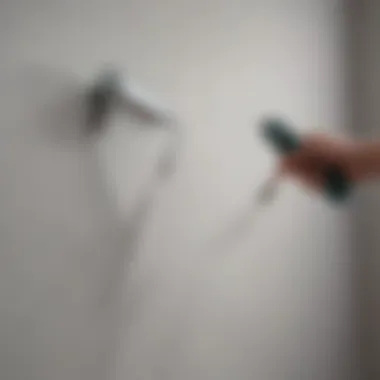
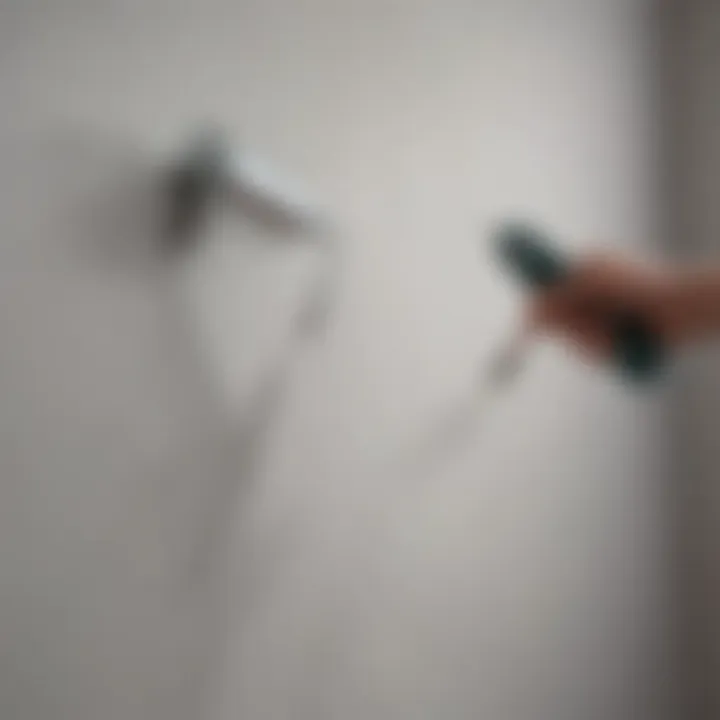
Sustaining the Fresh Look
Routine Maintenance
Routine maintenance is a specific aspect of sustaining the fresh look of your walls. It involves regular cleaning and light touch-ups as needed. This habit is a very beneficial choice; it helps keep walls looking their best while preventing wear over time. For instance, dusting or wiping surfaces monthly can help maintain cleanliness. If there are any marks or scuffs, addressing them immediately will minimize the need for extensive repainting.
A unique feature of routine maintenance is that it requires little effort over time, yet it can greatly prolong the life of your paint job. Regular attention can save you from needing a full repaint in the future, which is a significant advantage in maintaining a beautiful space.
Recognizing Damage Early
Recognizing damage early is another critical component to sustaining your painted walls. Regularly check the surfaces for signs of wear, such as peeling, bubbling, or discoloration. Early detection allows for timely touch-ups, preventing damage from worsening and ensuring that your walls stay looking good.
One key characteristic of this practice is its proactive nature. Being vigilant can save homeowners from costly repairs in the future. However, while it is generally advantageous, it can require some diligence. The unique feature lies in the potential to maintain aesthetics at low cost, making it a wise choice for anyone looking to preserve their interior space.
"A little effort spent on maintenance can save you much more in the long run."
Environmentally Conscious Painting
In recent years, the topic of environmentally conscious painting has gained significant attention. This shift is primarily because more people are becoming aware of how our choices impact the planet. When it comes to repainting interior walls, selecting eco-friendly options can lead to both health benefits and a more sustainable future. This section will explore two main aspects: the advantages of using low-VOC and eco-friendly paints and how to responsibly dispose of paint materials. In doing so, we can encourage a more informed and conscientious approach to home improvement projects.
Low-VOC and Eco-Friendly Paints
Volatile Organic Compounds, commonly referred to as VOCs, are harmful chemicals found in many conventional paints. These compounds can evaporate into the air, contributing to indoor air pollution. This poses health risks for individuals, especially those with respiratory issues. Choosing low-VOC and eco-friendly paints minimizes or eliminates these risks. Such paints typically have fewer harmful substances, making them a safer option for indoor applications. Moreover, many brands now provide paints that are labeled as sustainable and environmentally friendly, promoting healthier living spaces.
Benefits of low-VOC and eco-friendly paints include:
- Improved indoor air quality: Lowering VOC levels means reduction in harmful emissions.
- Sustainability: These products are often made from renewable resources, thus supporting a more sustainable approach.
- Odor reduction: Eco-friendly paints tend to have less strong odors, making the painting process more pleasant.
When selecting such paints, it's critical to read labels carefully. Look for certifications that validate a product's environmental claims. Notable certifications include Green Seal and the Global Greenguard Gold. Ensuring that the paint you choose has these labels means you are making a more informed decision.
Disposal of Paint Materials
Responsible disposal of paint materials is equally important in the pursuit of environmentally conscious painting. Many people overlook the waste generated during this process, which can include leftover paint, brushes, and other tools. Disposing of these materials improperly can lead to environmental harm and health risks.
Here are some guidelines for the correct disposal of paint materials:
- Leftover paint: Always check with local regulations for paint disposal. Many communities have hazardous waste collection days that accept old paint.
- Paint cans: If cans are empty, they can usually be recycled. However, if they contain leftover paint, ensure they are disposed of correctly.
- Brushes and rollers: If they are made for one-time use, many local garbage services will accept them in normal trash. However, check with your municipal regulations for specifics.
By following proper disposal procedures, you reduce the impact on landfills and protect the environment from hazardous substances. Furthermore, educating yourself on eco-friendly materials and disposal methods can lead to a more sustainable approach to home improvement.
"Every small effort counts when it comes to protecting our environment. With each paint project, consider how your choices can contribute to a healthier planet."
Common Mistakes to Avoid
Repainting interior walls can transform a room, but many people encounter avoidable pitfalls that can minimize the effectiveness of their efforts. Understanding these mistakes is crucial for achieving a professional look in your space. Recognition of these common errors is the first step toward ensuring a smoother process and better results. Being mindful of them will not only save you time and resources but also enhance the overall quality of your project.
Skipping Preparation Steps
Preparation is vital before any painting project. Many individuals overlook this phase, believing that once they have picked a color, the job begins. However, neglecting preparation leads to visible flaws, such as peeling paint or uneven texture.
Essential tasks such as cleaning the walls, filling holes, and ensuring surface smoothness are required. If walls are dirty, the paint will not adhere properly, leading to future maintenance issues. Using a primer can also help achieve a uniform appearance, especially if you are changing colors drastically. Skipping preparation steps can result in higher costs down the line due to the need for repairs or reapplication.
Underestimating Time and Costs
Time management is often underestimated in painting projects. It is easy to believe that a room can be painted in a day or two, but this oversight can lead to frustration. The drying time between coats, for example, is essential for a smooth finish.
Similarly, underestimating costs can place a financial strain on your project. Consider not only the cost of paint but also tools, brushes, drop cloths, and the potential need for professional help if things go awry. Having a clear plan and budget can mitigate surprises. It is recommended to allocate extra time and funds to accommodate for unexpected circumstances.
Ignoring Lighting Conditions
Lighting in a room profoundly impacts how paint colors appear. The same color can look vastly different under artificial light versus natural light. Choosing a color without testing it in the actual environment may lead to undesired results.
Before committing, apply samples of the chosen paint on the wall and observe how it interacts with the light at different times of day. Underestimating the effect of lighting can yield a finish that clashes rather than complements the intended design. This consideration is crucial for achieving harmony in your interior spaces.



